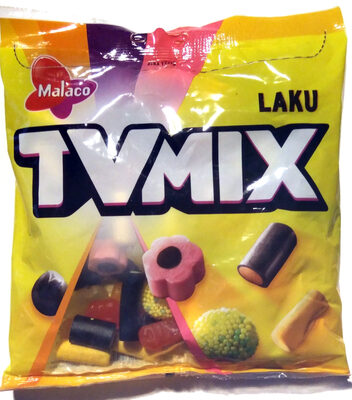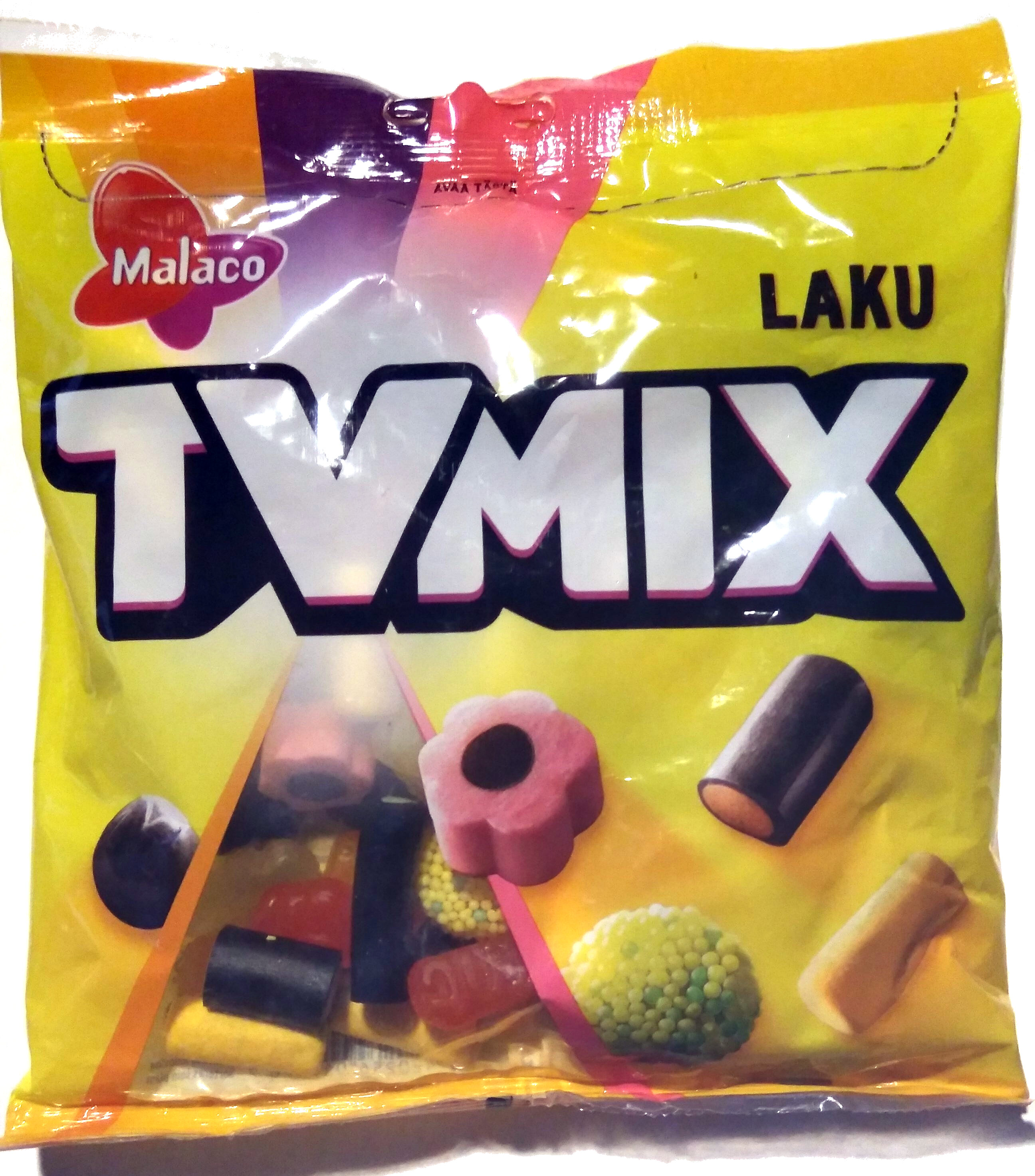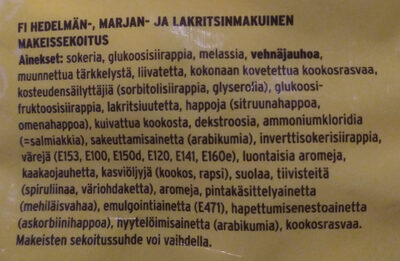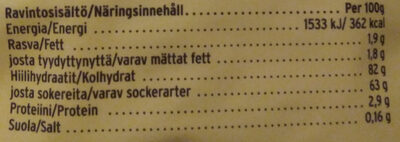Help us make food transparency the norm!
As a non-profit organization, we depend on your donations to continue informing consumers around the world about what they eat.
The food revolution starts with you!
TV Mix Laku - Malaco - 325 g
TV Mix Laku - Malaco - 325 g
This product page is not complete. You can help to complete it by editing it and adding more data from the photos we have, or by taking more photos using the app for Android or iPhone/iPad. Thank you!
×
Barcode: 6420256015476 (EAN / EAN-13)
Common name: Hedelmän-, marjan- ja lakritsinmakuinen makeissekoitus
Quantity: 325 g
Packaging: Plastic, Other-plastics
Categories: Snacks, Sweet snacks, Cocoa and its products, Confectioneries, Chocolate candies, Bonbons, Candies, Gummi candies
Labels, certifications, awards: Natural flavors
Link to the product page on the official site of the producer: https://www.cloetta.fi/tuotteet/makeispu...
Stores: K-market
Countries where sold: Finland
Matching with your preferences
Health
Ingredients
-
48 ingredients
: sokeria, glukoosisiirappia, melassia, vehnäjauhoa, muunnettua tärkkelystä, liivatetta, kokonaan kovetettua kookosrasvaa, kosteudensäilyttäjiä (sorbitolisiirappia, glyserolia), glukoosi-fruktoosisiirappia, lakritsiuutetta, happoja (sitruunahappoa, omenahappoa), kuivattua kookosta, dekstroosia, ammoniumkloridia (=salmiakkia), sakeuttamisainetta (arabikumia), inverttisokerisiirappia, värejä (E153, E100, E150d, E120, E141, E160e), luontaisia aromeja, kaakaojauhetta, kasviöljyjä (kookos, rapsi), suolaa, tiivisteitä (spiruliinaa, väriohdaketta), aromeja, pintakäsittelyainetta (mehiläisvahaa), emulgointiainetta (E471), hapettumisenestoainetta (askorbiinihappoa), hyytelöimisainetta (arabikumia), kookosrasvaa.Allergens: Gluten
Food processing
-
Ultra processed foods
Elements that indicate the product is in the 4 - Ultra processed food and drink products group:
- Additive: E100 - Curcumin
- Additive: E120 - Cochineal
- Additive: E141 - Copper complexes of chlorophylls and chlorophyllins
- Additive: E14XX - Modified Starch
- Additive: E150d - Sulphite ammonia caramel
- Additive: E153 - Vegetable carbon
- Additive: E160e - Beta-apo-8′-carotenal (c30)
- Additive: E414 - Acacia gum
- Additive: E420 - Sorbitol
- Additive: E422 - Glycerol
- Additive: E428 - Gelatine
- Additive: E471 - Mono- and diglycerides of fatty acids
- Additive: E901 - White and yellow beeswax
- Ingredient: Colour
- Ingredient: Dextrose
- Ingredient: Emulsifier
- Ingredient: Flavouring
- Ingredient: Gelling agent
- Ingredient: Glazing agent
- Ingredient: Glucose
- Ingredient: Glucose syrup
- Ingredient: Humectant
- Ingredient: Invert sugar
- Ingredient: Thickener
Food products are classified into 4 groups according to their degree of processing:
- Unprocessed or minimally processed foods
- Processed culinary ingredients
- Processed foods
- Ultra processed foods
The determination of the group is based on the category of the product and on the ingredients it contains.
Additives
-
E120 - Cochineal
Carminic acid: Carminic acid -C22H20O13- is a red glucosidal hydroxyanthrapurin that occurs naturally in some scale insects, such as the cochineal, Armenian cochineal, and Polish cochineal. The insects produce the acid as a deterrent to predators. An aluminum salt of carminic acid is the coloring agent in carmine. Synonyms are C.I. 75470 and C.I. Natural Red 4. The chemical structure of carminic acid consists of a core anthraquinone structure linked to a glucose sugar unit. Carminic acid was first synthesized in the laboratory by organic chemists in 1991.Source: Wikipedia
-
E296 - Malic acid
Malic acid: Malic acid is an organic compound with the molecular formula C4H6O5. It is a dicarboxylic acid that is made by all living organisms, contributes to the pleasantly sour taste of fruits, and is used as a food additive. Malic acid has two stereoisomeric forms -L- and D-enantiomers-, though only the L-isomer exists naturally. The salts and esters of malic acid are known as malates. The malate anion is an intermediate in the citric acid cycle.Source: Wikipedia
-
E330 - Citric acid
Citric acid is a natural organic acid found in citrus fruits such as lemons, oranges, and limes.
It is widely used in the food industry as a flavor enhancer, acidulant, and preservative due to its tart and refreshing taste.
Citric acid is safe for consumption when used in moderation and is considered a generally recognized as safe (GRAS) food additive by regulatory agencies worldwide.
-
E414 - Acacia gum
Gum arabic: Gum arabic, also known as acacia gum, arabic gum, gum acacia, acacia, Senegal gum and Indian gum, and by other names, is a natural gum consisting of the hardened sap of various species of the acacia tree. Originally, gum arabic was collected from Acacia nilotica which was called the "gum arabic tree"; in the present day, gum arabic is collected from acacia species, predominantly Acacia senegal and Vachellia -Acacia- seyal; the term "gum arabic" does not indicate a particular botanical source. In a few cases so‐called "gum arabic" may not even have been collected from Acacia species, but may originate from Combretum, Albizia or some other genus. Producers harvest the gum commercially from wild trees, mostly in Sudan -80%- and throughout the Sahel, from Senegal to Somalia—though it is historically cultivated in Arabia and West Asia. Gum arabic is a complex mixture of glycoproteins and polysaccharides. It is the original source of the sugars arabinose and ribose, both of which were first discovered and isolated from it, and are named after it. Gum arabic is soluble in water. It is edible, and used primarily in the food industry as a stabilizer, with EU E number E414. Gum arabic is a key ingredient in traditional lithography and is used in printing, paint production, glue, cosmetics and various industrial applications, including viscosity control in inks and in textile industries, though less expensive materials compete with it for many of these roles. While gum arabic is now produced throughout the African Sahel, it is still harvested and used in the Middle East.Source: Wikipedia
-
E420 - Sorbitol
Sorbitol: Sorbitol --, less commonly known as glucitol --, is a sugar alcohol with a sweet taste which the human body metabolizes slowly. It can be obtained by reduction of glucose, which changes the aldehyde group to a hydroxyl group. Most sorbitol is made from corn syrup, but it is also found in nature, for example in apples, pears, peaches, and prunes. It is converted to fructose by sorbitol-6-phosphate 2-dehydrogenase. Sorbitol is an isomer of mannitol, another sugar alcohol; the two differ only in the orientation of the hydroxyl group on carbon 2. While similar, the two sugar alcohols have very different sources in nature, melting points, and uses.Source: Wikipedia
-
E420ii - Sorbitol syrup
Sorbitol: Sorbitol --, less commonly known as glucitol --, is a sugar alcohol with a sweet taste which the human body metabolizes slowly. It can be obtained by reduction of glucose, which changes the aldehyde group to a hydroxyl group. Most sorbitol is made from corn syrup, but it is also found in nature, for example in apples, pears, peaches, and prunes. It is converted to fructose by sorbitol-6-phosphate 2-dehydrogenase. Sorbitol is an isomer of mannitol, another sugar alcohol; the two differ only in the orientation of the hydroxyl group on carbon 2. While similar, the two sugar alcohols have very different sources in nature, melting points, and uses.Source: Wikipedia
-
E422 - Glycerol
Glycerol: Glycerol -; also called glycerine or glycerin; see spelling differences- is a simple polyol compound. It is a colorless, odorless, viscous liquid that is sweet-tasting and non-toxic. The glycerol backbone is found in all lipids known as triglycerides. It is widely used in the food industry as a sweetener and humectant and in pharmaceutical formulations. Glycerol has three hydroxyl groups that are responsible for its solubility in water and its hygroscopic nature.Source: Wikipedia
-
E471 - Mono- and diglycerides of fatty acids
Mono- and diglycerides of fatty acids (E471), are food additives commonly used as emulsifiers in various processed foods.
These compounds consist of glycerol molecules linked to one or two fatty acid chains, which help stabilize and blend water and oil-based ingredients. E471 enhances the texture and shelf life of products like margarine, baked goods, and ice cream, ensuring a smooth and consistent texture.
It is generally considered safe for consumption within established regulatory limits.
-
E901 - White and yellow beeswax
Beeswax: Beeswax -cera alba- is a natural wax produced by honey bees of the genus Apis. The wax is formed into "scales" by eight wax-producing glands in the abdominal segments of worker bees, which discard it in or at the hive. The hive workers collect and use it to form cells for honey storage and larval and pupal protection within the beehive. Chemically, beeswax consists mainly of esters of fatty acids and various long-chain alcohols. Beeswax has long-standing applications in human food and flavoring. For example, it is used as a glazing agent or as a light/heat source. It is edible, in the sense of having similar negligible toxicity to plant waxes, and is approved for food use in most countries and the European Union under the E number E901. However, the wax monoesters in beeswax are poorly hydrolysed in the guts of humans and other mammals, so they have insignificant nutritional value. Some birds, such as honeyguides, can digest beeswax. Beeswax is the main diet of wax moth larvae.Source: Wikipedia
Ingredients analysis
-
May contain palm oil
Ingredients that may contain palm oil: E471
-
Non-vegan
Non-vegan ingredients: E428, E120, E901Some ingredients could not be recognized.
We need your help!
You can help us recognize more ingredients and better analyze the list of ingredients for this product and others:
- Edit this product page to correct spelling mistakes in the ingredients list, and/or to remove ingredients in other languages and sentences that are not related to the ingredients.
- Add new entries, synonyms or translations to our multilingual lists of ingredients, ingredient processing methods, and labels.
If you would like to help, join the #ingredients channel on our Slack discussion space and/or learn about ingredients analysis on our wiki. Thank you!
-
Non-vegetarian
Non-vegetarian ingredients: E428, E120Some ingredients could not be recognized.
We need your help!
You can help us recognize more ingredients and better analyze the list of ingredients for this product and others:
- Edit this product page to correct spelling mistakes in the ingredients list, and/or to remove ingredients in other languages and sentences that are not related to the ingredients.
- Add new entries, synonyms or translations to our multilingual lists of ingredients, ingredient processing methods, and labels.
If you would like to help, join the #ingredients channel on our Slack discussion space and/or learn about ingredients analysis on our wiki. Thank you!
-
Details of the analysis of the ingredients
We need your help!
Some ingredients could not be recognized.
We need your help!
You can help us recognize more ingredients and better analyze the list of ingredients for this product and others:
- Edit this product page to correct spelling mistakes in the ingredients list, and/or to remove ingredients in other languages and sentences that are not related to the ingredients.
- Add new entries, synonyms or translations to our multilingual lists of ingredients, ingredient processing methods, and labels.
If you would like to help, join the #ingredients channel on our Slack discussion space and/or learn about ingredients analysis on our wiki. Thank you!
: sokeria, glukoosisiirappia, melassia, _vehnäjauhoa_, muunnettua tärkkelystä, liivatetta, kokonaan kovetettua kookosrasvaa, kosteudensäilyttäjiä (sorbitolisiirappia, glyserolia), glukoosi-fruktoosisiirappia, lakritsiuutetta, happoja (sitruunahappoa, omenahappoa), kuivattua kookosta, dekstroosia, ammoniumkloridia (=salmiakkia), sakeuttamisainetta (arabikumia), inverttisokerisiirappia, värejä (e153, e100, e150d, e120, e141, e160e), luontaisia aromeja, kaakaojauhetta, kasviöljyjä (kookos, rapsi), suolaa, tiivisteitä (spiruliinaa, väriohdaketta), aromeja, pintakäsittelyainetta (mehiläisvahaa), emulgointiainetta (e471), hapettumisenestoainetta (askorbiinihappoa), hyytelöimisainetta (arabikumia), kookosrasvaa- sokeria -> en:sugar - vegan: yes - vegetarian: yes - ciqual_proxy_food_code: 31016 - percent_min: 3.57142857142857 - percent_max: 100
- glukoosisiirappia -> en:glucose-syrup - vegan: yes - vegetarian: yes - ciqual_proxy_food_code: 31016 - percent_min: 0 - percent_max: 50
- melassia -> en:molasses - vegan: yes - vegetarian: yes - ciqual_proxy_food_code: 31016 - percent_min: 0 - percent_max: 33.3333333333333
- _vehnäjauhoa_ -> en:wheat-flour - vegan: yes - vegetarian: yes - ciqual_proxy_food_code: 9410 - percent_min: 0 - percent_max: 25
- muunnettua tärkkelystä -> en:modified-starch - vegan: yes - vegetarian: yes - ciqual_proxy_food_code: 9510 - percent_min: 0 - percent_max: 20
- liivatetta -> en:e428 - vegan: no - vegetarian: no - percent_min: 0 - percent_max: 16.6666666666667
- kokonaan kovetettua kookosrasvaa -> en:fully-hydrogenated-coconut-fat - vegan: yes - vegetarian: yes - from_palm_oil: no - ciqual_food_code: 16040 - percent_min: 0 - percent_max: 14.2857142857143
- kosteudensäilyttäjiä -> en:humectant - percent_min: 0 - percent_max: 12.5
- sorbitolisiirappia -> en:e420ii - vegan: yes - vegetarian: yes - percent_min: 0 - percent_max: 12.5
- glyserolia -> en:e422 - vegan: maybe - vegetarian: maybe - percent_min: 0 - percent_max: 6.25
- glukoosi-fruktoosisiirappia -> en:glucose-fructose-syrup - vegan: yes - vegetarian: yes - ciqual_food_code: 31077 - percent_min: 0 - percent_max: 11.1111111111111
- lakritsiuutetta -> en:liquorice-extract - vegan: yes - vegetarian: yes - percent_min: 0 - percent_max: 10
- happoja -> en:acid - percent_min: 0 - percent_max: 9.09090909090909
- sitruunahappoa -> en:e330 - vegan: yes - vegetarian: yes - percent_min: 0 - percent_max: 9.09090909090909
- omenahappoa -> en:e296 - vegan: yes - vegetarian: yes - percent_min: 0 - percent_max: 4.54545454545455
- kuivattua kookosta -> en:desiccated-coconut - vegan: yes - vegetarian: yes - ciqual_food_code: 15007 - percent_min: 0 - percent_max: 8.33333333333333
- dekstroosia -> en:dextrose - vegan: yes - vegetarian: yes - ciqual_proxy_food_code: 31016 - percent_min: 0 - percent_max: 7.69230769230769
- ammoniumkloridia -> en:e510 - vegan: yes - vegetarian: yes - percent_min: 0 - percent_max: 7.14285714285714
- =salmiakkia -> en:e510 - vegan: yes - vegetarian: yes - percent_min: 0 - percent_max: 7.14285714285714
- sakeuttamisainetta -> en:thickener - percent_min: 0 - percent_max: 6.66666666666667
- arabikumia -> en:e414 - vegan: yes - vegetarian: yes - percent_min: 0 - percent_max: 6.66666666666667
- inverttisokerisiirappia -> en:invert-sugar-syrup - vegan: yes - vegetarian: yes - percent_min: 0 - percent_max: 6.25
- värejä -> en:colour - percent_min: 0 - percent_max: 5.88235294117647
- e153 -> en:e153 - vegan: yes - vegetarian: yes - percent_min: 0 - percent_max: 5.88235294117647
- e100 -> en:e100 - vegan: yes - vegetarian: yes - percent_min: 0 - percent_max: 2.94117647058824
- e150d -> en:e150d - vegan: yes - vegetarian: yes - percent_min: 0 - percent_max: 1.96078431372549
- e120 -> en:e120 - vegan: no - vegetarian: no - percent_min: 0 - percent_max: 1.47058823529412
- e141 -> en:e141 - vegan: yes - vegetarian: yes - percent_min: 0 - percent_max: 1.17647058823529
- e160e -> en:e160e - vegan: yes - vegetarian: yes - percent_min: 0 - percent_max: 0.980392156862745
- luontaisia aromeja -> en:natural-flavouring - vegan: maybe - vegetarian: maybe - percent_min: 0 - percent_max: 5
- kaakaojauhetta -> en:cocoa-powder - vegan: yes - vegetarian: yes - ciqual_food_code: 18100 - percent_min: 0 - percent_max: 5
- kasviöljyjä -> en:vegetable-oil - vegan: yes - vegetarian: yes - from_palm_oil: maybe - percent_min: 0 - percent_max: 5
- kookos -> en:coconut - vegan: yes - vegetarian: yes - ciqual_proxy_food_code: 15006 - percent_min: 0 - percent_max: 5
- rapsi -> en:rapeseed - vegan: yes - vegetarian: yes - percent_min: 0 - percent_max: 2.5
- suolaa -> en:salt - vegan: yes - vegetarian: yes - ciqual_food_code: 11058 - percent_min: 0 - percent_max: 0.16
- tiivisteitä -> fi:tiivisteitä - percent_min: 0 - percent_max: 0.16
- spiruliinaa -> en:spirulina - vegan: yes - vegetarian: yes - ciqual_proxy_food_code: 20984 - percent_min: 0 - percent_max: 0.16
- väriohdaketta -> en:safflower - vegan: yes - vegetarian: yes - percent_min: 0 - percent_max: 0.16
- aromeja -> en:flavouring - vegan: maybe - vegetarian: maybe - percent_min: 0 - percent_max: 0.16
- pintakäsittelyainetta -> en:glazing-agent - percent_min: 0 - percent_max: 0.16
- mehiläisvahaa -> en:e901 - vegan: no - vegetarian: yes - percent_min: 0 - percent_max: 0.16
- emulgointiainetta -> en:emulsifier - percent_min: 0 - percent_max: 0.16
- e471 -> en:e471 - vegan: maybe - vegetarian: maybe - from_palm_oil: maybe - percent_min: 0 - percent_max: 0.16
- hapettumisenestoainetta -> en:antioxidant - percent_min: 0 - percent_max: 0.16
- askorbiinihappoa -> en:e300 - vegan: yes - vegetarian: yes - percent_min: 0 - percent_max: 0.16
- hyytelöimisainetta -> en:gelling-agent - percent_min: 0 - percent_max: 0.16
- arabikumia -> en:e414 - vegan: yes - vegetarian: yes - percent_min: 0 - percent_max: 0.16
- kookosrasvaa -> en:coconut-fat - vegan: yes - vegetarian: yes - from_palm_oil: no - ciqual_food_code: 16040 - percent_min: 0 - percent_max: 0.16
Nutrition
-
Poor nutritional quality
⚠ ️Warning: the amount of fiber is not specified, their possible positive contribution to the grade could not be taken into account.⚠ ️Warning: the amount of fruits, vegetables and nuts is not specified on the label, it was estimated from the list of ingredients: 0This product is not considered a beverage for the calculation of the Nutri-Score.
Positive points: 0
- Proteins: 1 / 5 (value: 2.9, rounded value: 2.9)
- Fiber: 0 / 5 (value: 0, rounded value: 0)
- Fruits, vegetables, nuts, and colza/walnut/olive oils: 0 / 5 (value: 0.0236455883298667, rounded value: 0)
Negative points: 15
- Energy: 4 / 10 (value: 1533, rounded value: 1533)
- Sugars: 10 / 10 (value: 63, rounded value: 63)
- Saturated fat: 1 / 10 (value: 1.8, rounded value: 1.8)
- Sodium: 0 / 10 (value: 64, rounded value: 64)
The points for proteins are not counted because the negative points are greater or equal to 11.
Nutritional score: (15 - 0)
Nutri-Score:
-
Nutrient levels
-
Fat in low quantity (1.9%)
What you need to know- A high consumption of fat, especially saturated fats, can raise cholesterol, which increases the risk of heart diseases.
Recommendation: Limit the consumption of fat and saturated fat- Choose products with lower fat and saturated fat content.
-
Saturated fat in moderate quantity (1.8%)
What you need to know- A high consumption of fat, especially saturated fats, can raise cholesterol, which increases the risk of heart diseases.
Recommendation: Limit the consumption of fat and saturated fat- Choose products with lower fat and saturated fat content.
-
Sugars in high quantity (63%)
What you need to know- A high consumption of sugar can cause weight gain and tooth decay. It also augments the risk of type 2 diabetes and cardio-vascular diseases.
Recommendation: Limit the consumption of sugar and sugary drinks- Sugary drinks (such as sodas, fruit beverages, and fruit juices and nectars) should be limited as much as possible (no more than 1 glass a day).
- Choose products with lower sugar content and reduce the consumption of products with added sugars.
-
Salt in low quantity (0.16%)
What you need to know- A high consumption of salt (or sodium) can cause raised blood pressure, which can increase the risk of heart disease and stroke.
- Many people who have high blood pressure do not know it, as there are often no symptoms.
- Most people consume too much salt (on average 9 to 12 grams per day), around twice the recommended maximum level of intake.
Recommendation: Limit the consumption of salt and salted food- Reduce the quantity of salt used when cooking, and don't salt again at the table.
- Limit the consumption of salty snacks and choose products with lower salt content.
-
-
Nutrition facts
Nutrition facts As sold
for 100 g / 100 mlCompared to: Gummi candies Energy 1,533 kj
(362 kcal)+7% Fat 1.9 g +507% Saturated fat 1.8 g +1,150% Carbohydrates 82 g +2% Sugars 63 g +13% Fiber ? Proteins 2.9 g -16% Salt 0.16 g +31% Fruits‚ vegetables‚ nuts and rapeseed‚ walnut and olive oils (estimate from ingredients list analysis) 0.024 %
Environment
-
Eco-Score B - Low environmental impact
⚠ ️Select a country in order to include the full impact of transportation.The Eco-Score is an experimental score that summarizes the environmental impacts of food products.→ The Eco-Score was initially developped for France and it is being extended to other European countries. The Eco-Score formula is subject to change as it is regularly improved to make it more precise and better suited to each country.Life cycle analysis
-
Average impact of products of the same category: A (Score: 89/100)
Category: Jelly candy
Category: Jelly candy
- PEF environmental score: 0.21 (the lower the score, the lower the impact)
- including impact on climate change: 1.57 kg CO2 eq/kg of product
Stage Impact Agriculture
51.7 %Processing
31.1 %Packaging
7.6 %Transportation
7.3 %Distribution
2.3 %Consumption
0.0 %
Bonuses and maluses
-
Missing origins of ingredients information
Malus: -5
⚠ ️ The origins of the ingredients of this product are not indicated.
If they are indicated on the packaging, you can modify the product sheet and add them.
If you are the manufacturer of this product, you can send us the information with our free platform for producers.
-
Packaging with a medium impact
Malus: -10
Shape Material Recycling Impact Unknown O 7 - Other plastics High ⚠ ️ The information about the packaging of this product is not sufficiently precise (exact shapes and materials of all components of the packaging).⚠ ️ For a more precise calculation of the Eco-Score, you can modify the product page and add them.
If you are the manufacturer of this product, you can send us the information with our free platform for producers.
Eco-Score for this product
-
Impact for this product: B (Score: 74/100)
Product: TV Mix Laku - Malaco - 325 g
Life cycle analysis score: 89
Sum of bonuses and maluses: -15
Final score: 74/100
-
Carbon footprint
-
Equal to driving 0.8 km in a petrol car
157 g CO² per 100g of product
The carbon emission figure comes from ADEME's Agribalyse database, for the category: Jelly candy (Source: ADEME Agribalyse Database)
Stage Impact Agriculture
36.9 %Processing
38.1 %Packaging
11.9 %Transportation
12.0 %Distribution
1.1 %Consumption
0.0 %
Packaging
-
Packaging with a medium impact
-
Packaging parts
(O 7 - Other plastics)
-
Packaging materials
Material % Packaging weight Packaging weight per 100 g of product Plastic
-
Transportation
-
Origins of ingredients
Missing origins of ingredients information
⚠ ️ The origins of the ingredients of this product are not indicated.
If they are indicated on the packaging, you can modify the product sheet and add them.
If you are the manufacturer of this product, you can send us the information with our free platform for producers.Add the origins of ingredients for this product Add the origins of ingredients for this product
Report a problem
-
Incomplete or incorrect information?
Category, labels, ingredients, allergens, nutritional information, photos etc.
If the information does not match the information on the packaging, please complete or correct it. Open Food Facts is a collaborative database, and every contribution is useful for all.
Data sources
Product added on by jumati
Last edit of product page on by ecoscore-impact-estimator.
Product page also edited by musarana, openfoodfacts-contributors, packbot, roboto-app.











